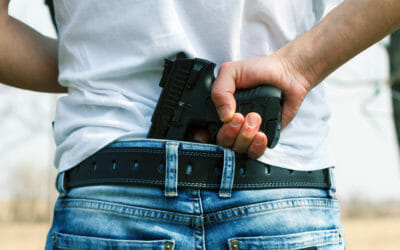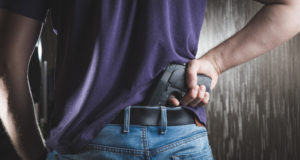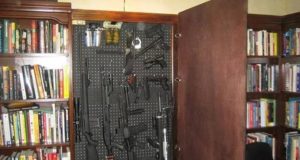
Staying battle ready with your handgun is a crucial survival skill set that must be practiced continually to ensure success.
We all think we can defend ourselves with a handgun of choice, as though we won’t panic. It’s as if we will have a cool head, muscle memory, clear thinking, and a steady hand. But when it comes to possibly taking another’s life, there usually isn’t time for deliberation. The most important decision you will make is how you prepare, practice, and train yourself prior to an event ever happening. Listed below are some interesting and helpful drills meant to aid you in staying battle ready in the case such an event occurs.
The Trigger Job
This simple task is about familiarizing your firearm to your hand AND breaking in the springs, trigger, and slide. Essentially, you will rack the slide and pull the trigger without any ammunition or magazine in the firearm. Do this while you are sitting on the couch, watching the game, or listening to the news. What you are doing is becoming familiar with the gun and learning the repetitive motions of racking the slide and approaching the trigger with your trigger finger.
Not only will you get a feel for your gun, but you will “season” it, break it in, and your hands will function naturally when behind the gun as a result of the repetition. Repeat the process 3,000-10,000 times. Sound excessive? As long as you are not using the magazine in the gun, or a rimfire, you are not hurting the gun in any significant fashion. Still worried? Use a snap cap. After 3,000 turns with this cycle, you cannot even imagine the control you will have over the slide and the feel of the trigger on your trigger finger. These are all positive outcomes for someone who is looking at staying battle ready.
Keep Your Handgun Locked and Loaded, Ready for Instant Use, Without Fear of An Accident…
Finger Control
Try setting a penny on the front sight of the firearm and steady your hand so that you can pull the trigger without tipping the balanced coin off the top of it. Take your time: learn the trigger feel and know what to expect with your gun. The extra time you take in staying battle ready will give you a better opportunity to know your trigger and build your finger dexterity. The slower and more precise you are with this action, the better you will be able to put a shot on target (the front sight can still be lined up with the rear notch). This is desirable from a practical standpoint, and the difference between this practice and the “trigger job” procedure is that you can build attenuation to the target in this practice.
Eventually, you will even be able to move the handgun around pretty far and pretty fast with a penny on the front sight and still keep from spilling it. Having this kind of control and knowing exactly how much your trigger takes to fire a shot is immensely important. It’s the type of information and subconscious muscle control that would cost a ton of money if you were using live ammunition. The key to this exercise is to take extra time and use every bit of the process to stress muscle memory and feel.
De-Holstering
This is a big key for staying battle ready. Knowing how to remove your gun from its holster in a variety of positions, under different stressful situations, and to accomplish different goals is of the utmost importance. You will want to not only learn the natural position for un-holstering your handgun, but you will want to practice from seated positions, in your car, at your desk, etc. Knowing how to remove the firearm and come to stance will be very important. Aside from knowing when to shoot and being psychologically prepared to defend your life, knowing how to remove a weapon from a holster will be the next most important thing. Snags, positioning on the holster, and a host of other things that might keep you from cleanly removing your gun from your holster are issues that need to be ironed out in private without outside influences and without stress.
Shoulder holster, inside the waistband, ankle holster or even a non-concealed or only partially concealed holster rig are each going to require different techniques and different muscle memory. Several hundred times per set are needed. I would make it a habit to spend an hour a week at minimum on this process until you can do it blindfolded while your spouse is shouting at the top of their lungs at you and you need to act quickly and come to the ready. No, really: have someone shout at you and be disoriented with a blindfold and see how you do. It’s necessary to train for scenarios that you normally wouldn’t simulate, as they will give you key practice for an unpredictable circumstance. The repetition will make you a pro during bad situations.
Off-Hand Shooting
It’s pretty self-explanatory: get good at an unsupported stance, learn the sight picture, and learn how to index yourself to a given target. Gain the proper muscle control to keep the gun steady and to hold the sights on target. Be able to keep the sight picture steady during trigger pull. The extra dexterity and stabilization will shine through in your normal combat stance as you seek to advance your prospects of staying battle ready.
Weak Hand Shooting
This is the opposite of above, but you do it to accomplish the same goal. Learn the sight picture differences, the depth perception changes, and the fatigue that come along with a weak hand shot. Try to become as close to proficient in weak hand off-hand shooting as you are in off-hand shooting. Try it with a penny balanced on the front sight. It will do wonders for you and help develop a calm and smoother draw and movement into full combat position.
Make Sure That You and Your Family Understands The Fundamentals of Gun Safety…
The Complete Process Repetition
This is the third most important task to master. It is only behind psychological preparedness and knowing when you will shoot and how to become ready for an intelligent shot and just behind the second most important part of de-holstering. What you need to be able to accomplish is full recognition of a threat situation. Furthermore, you should be able to draw your weapon without incidence, and then be able to stay on target after making a fast site acquisition. Then, of course, you must learn to pull the trigger while maintaining sight picture, accuracy, and calm.
This is a harder routine than you might think if you are being super critical of yourself and running through it slowly. You MUST be critical, and you MUST go through each motion several thousand times to become proficient. Do not be afraid that you look foolish practicing in a mirror or talking yourself through a complete process cycle. This is the one thing that will count when you are in a life-or-death situation and using your firearm to defend yourself. Be good at it, practice it often, do it slowly, and do it right the first time. This should be true even if it takes you two minutes and a storyboard or a checklist to ensure you are paying attention to details.
If you are practicing, you will know what to do. Your muscles will revert to their natural tendencies, and you should have no issue whatsoever staying battle ready. Moreover, you will be able to rely on the calm and peace of mind that comes from good training and full preparedness. You can also see a list of 5 recommended handguns here.
 Off The Grid News Better Ideas For Off The Grid Living
Off The Grid News Better Ideas For Off The Grid Living




